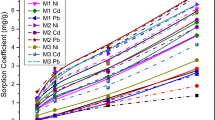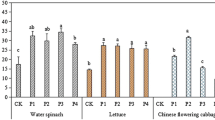Abstract
Fractionation of heavy metals (HMs) in amended soils is needed to predict elemental mobility in soil and phytoavailability to plants. A study was conducted to determine the effects of different amendments on HMs availability and their redistribution among soil fractions. A contaminated soil was selected from around a Zn mine and amended with 0, 2, 4, and 6 g kg−1 of vermicompost (VC), zeolite (ZE), and di-ammonium phosphate (DP) and incubated at field moisture. The amounts of Cd, Pb, Zn, and Cu were determined from the soil after 6 months of incubation time using DTPA and sequential extraction procedures. The total concentrations of Cd, Pb, Zn, and Cu were 41, 3,099, 1,997, and 83 mg kg−1 of soil, respectively. All amendments decreased significantly [probability (p) ≤ 0.05] DTPA-extractable Cd, Pb, and Cu, but not Zn, in the soil. For instance, DTPA-extractable Cd, Pb, and Cu decreased by 40, 290, and 20%, respectively, and that of Zn increased by 18% with DP1 (2 g kg−1 of di-ammonium phosphate) application. The concentrations of Pb and Cd decreased mainly in the specifically sorbed (SS) but increased in the amorphous Fe oxide (AFeO) fraction with DP application, indicating redistribution of Pb and Cd in the fractions with less mobility. Lead immobilization by DP was mainly attributed to the P-induced formation of chloropyromorphite, which was identified in the DP treatment using X-ray diffraction technique. It was concluded that DP was the most effective amendment in immobilizing Pb and Cd, though it increased Zn mobility.



Similar content being viewed by others
References
Abbaspour A, Kalbasi M, Shariatmadari H (2004) Effect of steel converter sludge as iron fertilizer and soil amendment in some calcareous soils. J Plant Nutr 27:377–394
Abbaspour A, Kalbasi M, Hajrasuliha S, Golchin A (2007) Effects of plant residue and salinity on fractions of cadmium and lead in three soils. Soil Sediment Contam 16:539–555
Abbaspour A, Kalbasi M, Hajrasuliha S, Fotovat A (2008) Effect of organic matter and salinity on ethylenediaminetetraacetic acid-extractable and solution species of cadmium and lead in three agricultural soils. Commun Soil Sci Plant Anal 39:983–1005
Ansari Mahabadi A, Hajabbasi MA, Khademi H, Kazemian H (2007) Soil cadmium stabilization using an Iranian natural zeolite. Geoderma 137:388–393
Basta NT, Gradwohl R, Snethen KL, Schroder JL (2001) Chemical immobilization of lead, zinc, and cadmium in smelter-contaminated soils using biosolids and rock phosphate. J Environ Qual 30:1222–1230
Bigham JM (1996) Method of soil analysis. Part 3. Chemical methods, American Society of Agronomy, Inc, Madison
Bolan NS, Adrian DC, Duraisamy P, Mani A (2003) Immobilization and phytoavailability of cadmium in variable charge soils. III. Effect of biosolid compost addition. Plant Soil 256:231–241
Brazauskiene DM, Paulauskas V, Sabiene N (2008) Speciation of Zn, Cu, and Pb in the soil depending on soil texture and fertilization with sewage sludge compost. J Soils Sediments 8:184–192
Brown S, Chaney RL, Hallfrisch JG, Xue Q (2003) Effect of biosolids processing on lead bioavailability in an urban soil. J Environ Qual 32:100–108
Cao X, Ma LQ, Chen M, Singh S, Harris WG (2002) Impacts of phosphate amendments on lead biogeochemistry at a contaminated site. Environ Sci Technol 36:5296–5304
Castaldi P, Santona L, Melis P (2005) Heavy metal immobilization by chemical amendments in a polluted soil and influence on white lupin growth. Chemosphere 60:365–371
Chelopecka A, Adriano DC (1996) Mimicked in situ stabilization of metals in a cropped soil: Bioavailability and chemical form of zinc. Environ Sci Technol 30:3294–3303
Chelopecka A, Adriano DC (1997) Influence of zeolite, apatite and Fe-oxide on Cd and Pb uptake by crops. Sci Total Environ 207:195–206
Chen M, Ma LQ, Singh SP, Cao RX, Melamed R (2003) Field demonstration of in situ immobilization of soil Pb using P amendments. Adv Environ Res 8:93–102
Dudka S, Adriano DC (1997) Environmental impacts of metals ore mining and processing: a review. J Environ Qual 26:590–602
Fayiga AO, Lena Q, Ma LQ (2006) Using phosphate rock to immobilize metals in soil and increase arsenic uptake by hyperaccumulator Pteris vittata. Sci Total Environ 359:17–25
Han FX, Banin A (1999) Long-term transformation and redistribution of potentially toxic heavy metals in arid-zone soils: II. Incubation at the field capacity moisture content. Water Air Soil Pollut 114:221–250
Hettiarachchi GM, Pierzynski GM (1999) Effect of phosphorus and other soil amendments on soil lead, cadmium, and zinc bioavailability, In: Proceedings of 5th International Conference on biogeochemistry of trace elements, Vienna
Hettiarachchi GM, Pierzynski GM, Ransom MD (2001) In situ stabilization of soil lead using phosphorous. J Environ Qual 30:1214–1221
Iskandar IK (2001) Environmental restoration of metals-contaminated soils. LEWIS Publishers, CRC Press, Boca Raton
Karaca A (2004) Effect of organic wastes on the extractability of cadmium, copper, nickel, and zinc in soil. Geoderma 122:297–303
Laperche V, Traina SJ, Gaddham P, Logan TJ (1996) Chemical and mineralogical characterizations of Pb in a contaminated soil: reactions with synthetic apatite. Environ Sci Technol 30:3321–3326
Laperche V, Logan TG, Gaddam P, Traina SJ (1997) Effect of apatite amendments on plant uptake of lead from contaminated soil. Environ Sci Technol 31:2745–2753
Ma LQ, Rao GN (1997) Chemical fractionation of cadmium, copper, nickel, and zinc in contaminated soils. J Environ Qual 26:259–264
Mavropoulos E, Rocha NCC, Moreira JC, Rossi AM, Soares GA (2004) Characterization of phase evolution during lead immobilization by synthetic hydroxyapatite. Mater Charact 53:71–78
McGowen SL, Basta NT, Brown GO (2001) Use of diammonium phosphate to reduce heavy metals solubility and transport in smelter-contaminated soil. J Environ Qual 30:493–500
Oste LA, Lexmond TM, Van Riemsdijk WH (2002) Metal immobilization in soils using synthetic zeolites. J Environ Qual 31:813–821
Sanchez-Martin MJ, Garcia-Delgado M, Lorenzo LF, Rodrigues-Cruz MS, Arienzo M (2007) Heavy metals in sewage sludge amended soils determined by sequential extractions as a function of incubation time of soils. Geoderma 142:262–273
Sneddon IR, Orueetxebarria M, Hodson ME, Schofield PF, Valsami-Jones E (2006) Use of bone meal amendments to immobilise Pb, Zn and Cd in soil: a leaching column study. Environ Pollut 144:816–825
Tessier A, Campbell PGC, Bisson M (1979) Sequential extraction procedure for the speciation of particulate trace metals. Anal Chem 51:844–885
Theodoratos P, Papassiopi N, Xenidis A (2002) Evaluation of monobasic calcium phosphate for the immobilization of heavy metals in contaminated soils from Larvon. J Hazard Mater 94:135–146
Yang J, Mosby DE, Casteel SW, Blanchar RW (2001) Lead immobilization using phosphoric acid in a smelter-contaminated urban soil. Environ Sci Technol 35:3553–3559
Zhang P, Ryan JA (1998) Formation of pyromorphite in anglesite-hydroxyapatite suspensions under varying pH conditions. Environ Sci Technol 32:3318–3324
Acknowledgments
This work was supported by the research grant from Shahrood University of Technology. The authors gratefully thank the assistance provided by Dr. J.M. Arocena, professor in Environmental Science Department, University of Northern British Columbia, Prince George, BC, Canada, for XRD analyses of the samples and Shawn Botton for editing the paper.
Author information
Authors and Affiliations
Corresponding author
Rights and permissions
About this article
Cite this article
Abbaspour, A., Golchin, A. Immobilization of heavy metals in a contaminated soil in Iran using di-ammonium phosphate, vermicompost and zeolite. Environ Earth Sci 63, 935–943 (2011). https://doi.org/10.1007/s12665-010-0762-5
Received:
Accepted:
Published:
Issue Date:
DOI: https://doi.org/10.1007/s12665-010-0762-5




